Yale Exkursion 2009
From march 6th to march 18th 2009 Prof. Suda and students of the School of Forest Science and Resource Management of the TUM had a field trip to the American South-East. Together with students of the Yale School of Forestry and Environmental Studies they discovered along a 2000 miles route different topics concerning forestry, environmental and ecological research. The main topic of the excursion was the "American Wood Basket"
The participants of the field trip got a great impression about forest ecosystems, demands on nature and different mindsets in this part of the USA. During 12 day the students had the possibility to do networking with students of other universities and forest colleges, to meet forest and timber companies and to get an impression of scientific work.
The field trip started at Memphis, TN, had stops along the Mississippi river, went to the state of Alabama and ended at Ashville, NC.
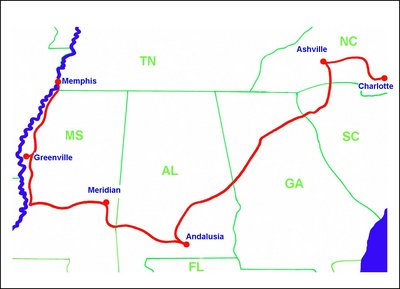
March 6th
Flight from Munich to Memphis, TN
March 7th
US Forest Service Center of Bottomland Hardwoods Research
The first of the excursion we visited the “US Forest Service Center of Bottomland Hardwoods Research” near Greenville, MS. One of the leading scientists introduced our group concerning the center. He showed us for example sample areas for the research of “Southern Spicebush” (Lindera melissifolia). The scientists want to prove the growth conditions of this red list species under different requirements of sunlight and water supply.
After visiting these areas the group was given the opportunity to learn more about the specific tree species and vegetation of the bottomland hardwoods. As one impressive example Sweetgum trees can be told.
By the end of the day a final highlight waited in the twilight, when we saw two alligators swimming in a little lake.
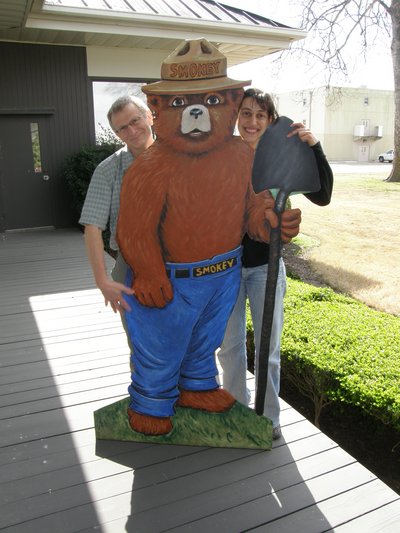
March 8th
The US Forest Service Crossett Experimental Forest
On Sunday 8th of March 2009 we started at 8 am and after picking up Brian Lockhart from the US Forest Service we crossed the Mississippi and entered Arkansas before arriving the US Forest Service Crossett Experimental Forest.
We saw an introductory movie about the research station. Afterwards we drove to the woods which consisted of loblolly and longleaf pine. The Size of the research station´s woods is an area of 600 ha, divided into different sections where experiments are carried out. This station is financed by the US government in order to support forest owners.
Here we learned about the single tree selection and regeneration. In their forests they use herbicide every three to ten years, in order to control the undergrowth. Every couple of years the do controlled burns. This helps to keep the floor grassy but it also burns the natural regeneration, which is an unwanted side effect.
Later that day we also saw the natural area where they leave broadleaved trees in order to improve biodiversity and keep older trees as a habitat for woodpeckers. Further they told us about the tree improvement program where they select the best trees in order to produce high quality seeds for loblolly pine stands.
After a lunch, at the research station, we saw group selection and shelter wood management.
During this interesting day we saw silviculture similar to the European system. Many of us had only studied these management options but had never seen them the woods itself. The day ended with a great dinner in a casino close to the Mississippi river.
March 9th
The Anderson Tully lands
On Monday March the 9th we left at 8:30 am for the lands of the Anderson Tully Company near Vicksburg.
On our way we stopped at a store town were the story of the popular Teddy Bear began. It was a neat, old little store and we had a good occasion for taking pictures, rest a little bit and to discover why the Teddy Bear is named Teddy Bear: Because of Teddy Roosevelt who wanted to shoot a Bear near by this place.
When we arrived at the Anderson Tully lands we met our guide. He showed us a small part of the 325000 acres the Anderson Tully Company owns along the Mississippi River from Memphis to Vicksburg. They have also two mills close to the river where they bring the cut wood, what is about 75 Million feet per year.
Our guide told us about the different treatments they do and did in their forests. By the 1980´s they did single tree selection. Later they changed to group selections because they wanted to support regeneration in the stands. Therefore they manage a combination of uneven and even aged stands. For example in wide areas they planted instead of red oak and sweet gum only cotton wood. Therefore they used 13 very productive clones.
After the presentation we saw a lot of different colored frogs in the puddles besides the road, which was very entertaining.
After that we left for lunch to a small hovel in the hills. From there we started again to a very interesting part of the ATCO forest, a part that is left untreated for a couple of years now. The area was formed by glacier sediment. Because of these sediments the soil is very productive, but also has a high risk of erosion. We talked about the natural regeneration and then we walked around the stand and the students from Yale specified all the different tree species there.
After this walk we left in the late afternoon for Meridian what was a two-hour-drive. Our Dinner was near by the Motel. And after we refreshed us we left for a bar in the town where we enjoyed our evening, playing Billiard and listening to a three-man-band.
March 10th
The T.R. Miller Mill Company
The first stop of this day has been close the town Andalusia, at the forest areas of a longleaf pine company. Here we had our first impressions of Longleaf Pine (Pinus Palustris). Longleaf Pine is a special tree species which is domestic to the American Southeast and nowadays endangered. One special thing about Longleaf Pine is it’s high resistance towards forest fires. This fire resistance is used by some of the forest owners. With controlled burns they do fire thinning, while most of the lower vegetation such as hardwoods are killed, Longleaf Pine will survive the fire. In addition it benefits, because needles which are afflicted by a disease are burned up and grow again healthy.
In the afternoon we visited the mill of the T.R. Miller Company. The T. R. Miller Mill Company, Inc. is located in Brewton, AL. It is one of the oldest, privately held, forest product companies in business today, built in 1848. On one side T.R. Miller is a company processing timber, on the other side it is also a big forest owner, managing about 215.000 acres of forests. During the sawmill tour we had great impressions of the organizatin and workflow in a big company like T.R. Miller. Also it was quite funny to see the hole group wearig orange safety vests and glasses.
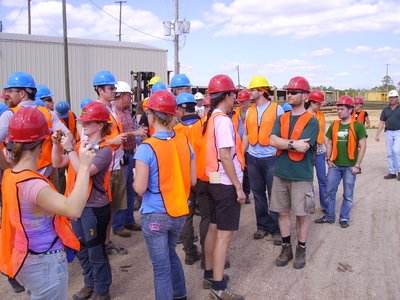
March 11th
Solon Dixon Center
At seven o’clock early in the morning we started our first day at the Solon Dixon Center. After the breakfast our host Joel Martin introduced us to the Solon Dixon Forestry Center.
The land that now belongs to the Solon Dixon Forestry Center was donated to Auburn University by Martha and Solon Dixon and so a Forestry School was established in 1978. The objective is education at university level about the management of forests and wildlife particularly for Auburn University students. Its facilities located in Andalusia, AL provide classrooms, living accomodations and a diverse 5,300 acres forest.
The school is self-sustaining from their timber, hunting licenses and some agricultural land.
The second speaker of this morning was Mark J. Hainds from the Longleaf Alliance.
The Longleaf Alliance provides education and information to resource-managers and private landowners about the longleaf pine (pinus palustris) ecosystem. It is a system highly dependant on regular fires and it’s diversity would be destroyed by keeping fire out. The fire removes the competitors of longleaf pine leading to open longleaf pine forests which again provide habitat for adapted animals like quail-birds.
After these presentations we went out into the woods to take a closer look at some experimental stands. The first study subject was a comparison of container seedlings vs. bare root seedlings. Other studies included a clear-cut stand treated with chemicals, a shelter-wood with natural regeneration.
Back at the camp at half past twelve we enjoyed Burger, Fries, Salad and a very sweet cake before listening to the third talk by Dale Pancake. He prepared us with details about prescribed burning for the afternoon.
The fire behavior is determined by wind, temperature, humidity and fuel accumulation. Fuels are shrubs, needles, leaves, dead wood and its amount is regulated by the time since the last burning. As a consequence of this accumulation of fuel, natural fires would not be so devastating if the fire hadn’t been kept out for years.
The fire is set in strips moving against the wind and having the fire spread within wind direction. The prescribed burn is kept under control with the distance of the strips, aisles (path, road, stream, field) and slow back-up fires spreading against the fire line.
At 2pm we went out in the forest again and could see a prescribed burn. The conditions were a weak wind from south-east and a very dry stand. A test fire was set to determine the wind direction and after that they started the fire line. The flames were shooting very high and our professional arsonists became a little nervous. The wind was too weak and it was too dry. They decided not to burn the whole area and to put the fire out halfway with a bulldozer.
In the late afternoon some of us decided to spend the evening at Florida’s white Beach. It was only a short drive of one and a half hour and we arrived just in time to enjoy the beautiful sunset.
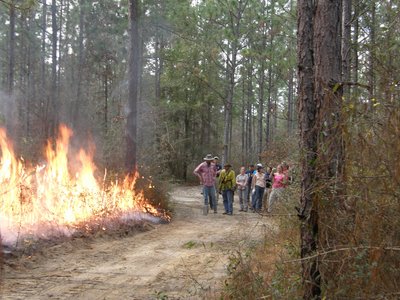
March 12th
The day of the road trip
This Thursday was the day of the longest road trip in the entire excursion, as we were traveling from Andalusia in the South of Alabama to Ashville in North Carolina. However, the day was not only based on traveling. Early in the morning before starting the trip we went to visit a short rotation pine forest owned by Rayonier, a forest products company that owns, leases or manages 2.6 million acres of timberland in the U.S. and New Zealand and sells timber for use in domestic and export markets.
The group met the forest managers of the company for this zone at the Solo Dixon center. Some of us had the luck to share the car with one of them, so it was possible to talk about some facts of the company and the forest, like species or management techniques. One of the most interested topics commented, was the strict policy that the company uses according watershed protection, following the proposals of the forest agency for water management control.
The main species that are harvested in this forest are mainly loblolly pine but also, slash pine. The main destinies of the products are small sizes for paper and fiber industry. Thus the rotation period is very short, having normally only one thinning, with a final cut around 30 years sometimes even around 23 years. It was commented during the morning, that the economic crisis is forcing the company to modify their management measures and treatments. Thus despite that the market demand has drastically dropped, the logging is continuing in order to keep the labor working, while they wait for the recuperation of the market.
In the second stop we went to see an operation in the field, when a harvester was doing a systematic thinning in fascines. This kind of harvester is able to cut several stems and hold them at the same time. It was explained that the size of the harvester was perhaps too big for this type of practice, although its efficiency could compensate its cost. Moreover we could see the forwarder working at the same time and have a chat with the drivers.
The last stop was done in an area that was just cleared to keep the labor working, without expecting to use the timber afterwards. Thus the logging practices were very intensive without taking care about damages to timber or selection. The branches were quickly pruned and left on the ground and the stems extracted.
Finally, after this last stop, the group had to say goodbye to Mike Ferruci and go back to the cars and drive until Asheville. In this occasion there wasn’t any caravanning, as each single car had to find its way until the destination. The trip happened without any problems and everybody arrived at night to the “4-H Camp” in Asheville.
March 13th
– Day off
March 14th
Great Smoky Mountain National Park
After entering the national park our convoy drove to the Cataloochee Valley, where we were given a presentation in a former church building by the National Park ranger, Paul Super, from the resource science and management division of the park administration. The division deals with such diverse topics as wildlife management, in particular elk and bear reintroduction, fisheries management, invasive species, monitoring, inventory as well as soils and rare big trees.
In the beginning Paul Super presented some of the facts about the park. With 9 million visitors, it is the most visited park in the U.S., just like being one of the oldest. It was created in 1916 with the aim of balancing preservation and recreation. This involves coping with the impact of the visitors, which range from poaching to trampling and littering. Due to these impacts and the former land use by settlers lead to the fact that the National Park now needs to be managed and cannot be designated as a complete wilderness area. Nevertheless some areas of old growth forest exist and a large variety of wildlife is prevalent. Elks, that previously became extinct in the area, were brought back in from fenced in populations. The reintroduced animals are now breeding in the Park in late May and maintain a stable population.
At the end of his talk Paul Super stressed that the existence of the park depends to a great extend on the acceptance of the local community and its perception. They just like all the visitors need to take ownership of the Park in order to ensure the continuing success of the efforts towards conservation and recreation in the Smokey Mountains.
The second item of the agenda was a guided hike together with Dr. Tom Showalter and other staff from the Warren Wilson College, which would lead to group to some of the ecologically and historically important sites along the Boggerman Trail. The Yale-TUM crowd split up in two groups and tackled the 8 mile trail from opposite directions.
Several historical objects, such as houses, dry stone walls, a graveyard, etc. could be found along the trail and are a sign of the early settlement of the region.
Besides the early history of human settlement in the region, we also heard about the problems of the invasive species with regard to hemlocks and visited some of the old growth areas in the Park. Large specimen of among other trees cherry bark oak, missa and poplar were impressive testimony of the unspoiled nature present in the Park.
March 16th
Visit of the Coweeta Hydrologic Laboratory (N.C.)
On March 16th, we visited the Coweeta Hydrologic Laboratory, which is a research site of the Southern Research Station, Forest Service, U.S. Department of Agriculture. The mission of the Laboratory is to describe and understand the physical and biological processes that influences water as it moves through the forested watershed. The goal is to predict the effects of management practices and atmospheric deposition in mountain lands upon the quantity and quality of water in streams.
The Laboratory lies in a forested valley near the northern end of the Appalachian Mountain chain. Vegetation is southern mixed deciduous forest. The slopes are covered by deep sandy loam soils underlain by folded schist and gneiss. Streams flow throughout the year, fed by an average of 2035 mm of precipitation per year, most of which is rain.
Coweeta Hydrological Laboratory tries to identify management practices that mitigate impacts on watershed resources. This is done through evaluating, explaining and predicting how water and soil as well as forest resources respond to different management practices and natural disturbances such as multiple use forest management, mountain farming, woodland grazing, logging techniques, conversion from hardwood to white pine, and forest cuttings in several patterns.
Detailed studies have investigated distribution patterns of precipitation in space and time, water balance of plants and soils, water yielding processes of soils, storm and seasonal regimes of stream flow, distribution of aquatic insects, habitat preferences of trout, atmospheric deposition, nutrient cycling and forest productivity, and ecosystem responses to natural and man-made caused disturbances.
During our visit we were introduced to experiments conducted at watershed number 7. The watershed covers an area of 59 ha of forest, which was commercially clear-cut using a mobile cable system in 1977 to provide a starting point for an interdisciplinary study of physical, biological and chemical effects on terrestrial and aquatic components of the watershed, after a clear-cut. The study showed that the response of the stream-flow was an initial increase, followed by a decreasing of water-flow proportional to regrowth. An increase in sediment was discovered during the first few years as the roads were unstable. There was also a slight increase in stream nutrient content, which rapidly recovered. The long-term data showed increased N loss in the past 10 years. Concerning C and N, the soil chemical analysis showed increased total C and N and exchangeable cautions following cutting. The response of the vegetation was rapid, as result of the high productivity and diversity of the forest in this region.
March17th
Bent Creek Experimental Forest & Warren Wilson College
Last but not least our last day: The morning till noon we spent in the Bent Creek Experimental Forest. This research and demonstration forest is part of the national forest system and was established in 1925.
At the station we got a short introduction to the studies they did for the last 84 years. From there we drove directly to the woods to see this in reality. Dr. David Loftis from the Forest Service told us a lot about the upland Hardwood Silviculture, the ecosystem and species. Conspicuously in this stands is the good natural regeneration - but only by application of herbicides as we saw everywhere on our trip.
Some of the studies we heard about in the introduction we could consider, for example a plot where a study about a single tree selection treatment runs.
Our next stop was Warren Wilson College where our host Dr. Dave Ellum is one of the college teachers. After a short Lunch break he told us about the College nowadays and in former times.
In the College forest near by the students demonstrated us the cutting of a tree and how they do horse logging. Meanwhile they transported the log to the sawmill we had a look at the shitake mushroom cultivation, the Warren Wilson College students maintain. For understanding, each student of this college has a different job he has to work for a couple of hours a week.
From other students we got then a demonstration at the sawmill, where they sawed the trunk from before.
After all this demonstration we turned over to the relaxed part of the day. We had a great Pulled Pork with Coleslaw for dinner that the students prepared for us in a huge barrel since the evening before. And, what we didn´t wanted to miss: Mr. Suda’s theatre!
And with a lot of fun and good conversations we let our last evening end.
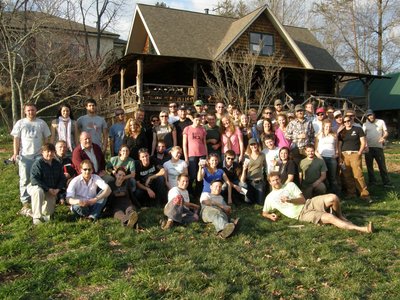
March 18th
Flight back from Charlotte to Munich